Estimated reading time: 7 minutes
Memories: Off To Hawaii in 1951! My father was raised in Arkansas and experienced the Great Depression while living in Southern California. Unfortunately, he never had the opportunity to travel much. My mother was the same way but feared flying and sailing. Their travels were limited to car trips, which they often did. In the late 1940s, they embarked on a month-long vacation where they drove through 32 different states. Despite no photographs of their journey, I have heard many stories about their adventures.
In 1951, my dad decided to go to Hawaii with or without my mom. After researching fares, he chose to travel on a freighter called the Hawaiian Pilot, which the Matson Lines operated. Unlike some people, my dad was not a fan of the Lurline.

The construction of the so-called C-3 cargo vessels began during World War II, after the famous “Liberty” and “Victory” ships. This standardized type of ship overtook all other ships as it was more modern and longer and could also reach a higher speed. After the Second World War, these ships were converted into ordinary freighters and sold to various shipping companies. The Hawaiian Pilot was built in 1944 and first went into service as the USS Burleigh. After the war ended, it was acquired and refitted by the Matson Navigation Company and mainly traveled the Los Angeles, San Francisco, and Hawaii routes. The cargo consisted of everyday consumer goods of all kinds and agrarian products primarily bound for the West Coast of the USA. The vessel had a cruising speed of 16.5 knots and a total cargo capacity of 12,500 tonnes.
My dad took around ten photos during a trip he took years ago, but unfortunately, they were lost over time. The pictures weren’t of excellent quality, as they were grainy and black and white. Despite this, my dad had a great time on the trip. He was one of twelve passengers on the ship and was treated as a special guest, which gave him access to the ship’s kitchen and privileges. He thoroughly enjoyed the entire experience!
Our guests are getting ready to leave. Chuck and Lisa will go to North Carolina tomorrow morning, and Colleen will leave for New Hampshire in the evening. Since they were busy today, Mary and I handled things around the house.
I hope she never finds out I put a battery-powered toy rabbit in the yard and pulled him along with a string forcing Mary to chase it.
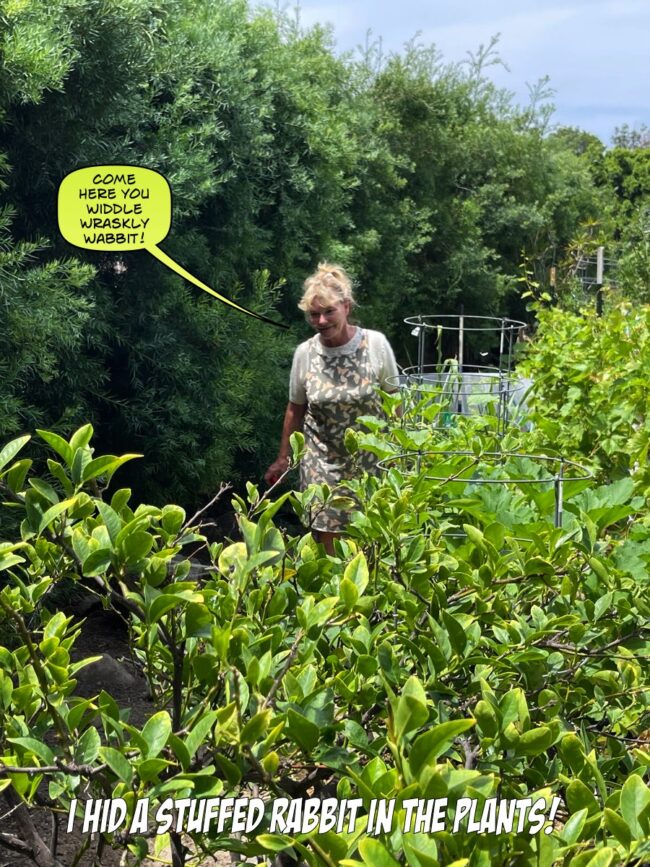
Mary was chasing rabbits in the yard.
This popped into my photos today, which I remembered growing up. Kids played together, and color was never an issue. Sadly, our nation is being torn apart by crazy ass liberals who make everything about race; treat your fellow man like you want to be treated, and we would be much better off!

Race relations in the 1930s
This morning, I stepped on the scale and was surprised it showed 200.0 pounds. I need to lose two more pounds before Saturday so I can wear my cummerbunds on my trip. Whenever I weigh over 200 pounds, the cumberbund slips down to my knees, which attracts a lot of laughter from onlookers.
Did You Know? The word cummerbund is the Anglicized form of Hindustani kamarband, which is, in turn, from Persian. It entered the English vocabulary in 1616 from India. It is a combination of the words kamar meaning ‘waist’, and band meaning ‘strap’ or ‘lacing’.
The rental goodies are all gone, so I watered the yard twice to make up for going without water for three days. The grass is dead where the light stands were positioned because a) they were heavy and b) they were made of black steel, making it like an iron on the grass. In a few days, things will be back to normal!
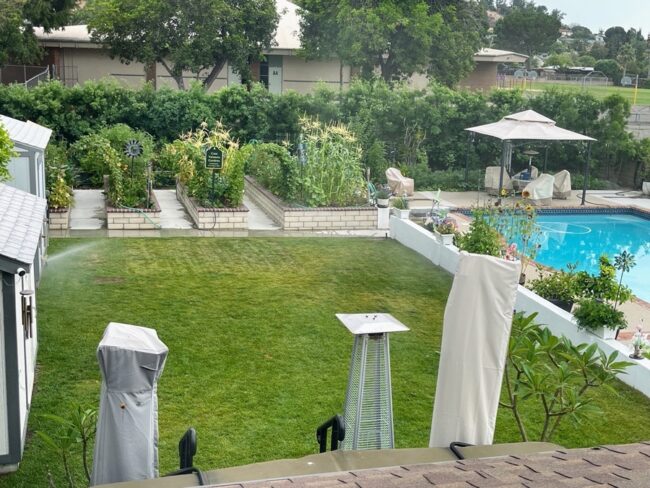
We watered the grass three times since it was dried for the party.
We took the cars out of the garage and decided to organize the cabinets. While cleaning the workshop, I was pleasantly surprised to discover a workbench hidden beneath all the clutter. My first task was fixing Mary’s hat box, which I successfully accomplished with surgical pliers and Elmers Glue.
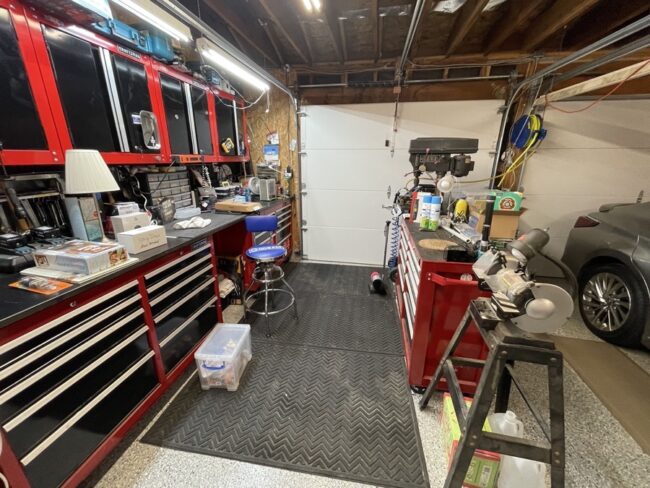
OMG, there is a workbench under the piles of stuff.
During the cleanup, two women passed by while walking their dog. We had spoken before, and they had complimented the house’s beauty. I offered a tour of the ” South Forty,” which they found astonishing. Mary brought out two shopping bags, and we filled them with tomatoes, onions, Swiss chard, and other fresh produce from the garden. It’s fantastic to have such great neighbors.
Gardening requires lots of water—most of it in the form of perspiration.
After they departed, we continued in the garage!

Now I can repair things again!
Colleen returned home, and we had a glass of wine before swimming. The water was 91 degrees, thanks to the summer sun!

Time to swim!
As we reclined in the water, we were treated to a breathtaking view of the sky, courtesy of Mother Nature.
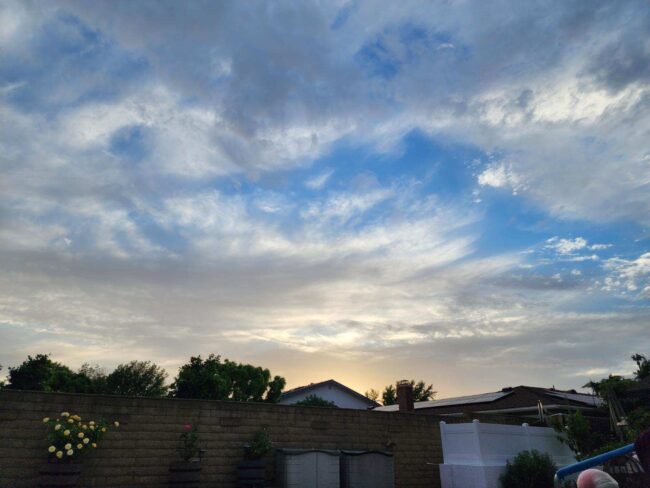
The sky was magnificent!
The sun is down, and the firepit is writhing with furor; it’s marshmallow time! We poked our wooden sticks into those little critters and created squishy sugar balls.

Burn, Baby Burn!
Did You Know? The humble marshmallow has a long history that traces back to the ancient world, beginning with the marshmallow plant. Found in Eurasia and Africa, this flowering beauty grows along marshes, hence marshmallow (via Southern Living). But the plant isn’t just pretty to look at. Its root and sap have long been known to be delicious and medicinal. As detailed by Herbalgram, the first reported use of the marshmallow plant was as early as the 9th century B.C. in Greece. The Greeks knew the plant had therapeutic properties and soothed throat inflammation. But, this medicinal use wasn’t limited to Greece. The marshmallow plant was widely used as a medicine in the ancient world.
Herbalgram reports that the marshmallow plant was widely used in the Arab world as well. It even earned a mention in India’s famous Ayurvedic pharmaceutical encyclopedia. The book observed, just as the Greeks did, that the plant’s roots could be used to alleviate coughs and even aid in healing severe afflictions like bronchitis. It’s interesting to note that it seems like humans have been drawn to marshmallows for the longest time.
With this major demand for marshmallows, it seemed like only a matter of time before candy engineers would find a way for the marshmallow-making process to become both cost- and time-effective. About 50 years later, according to ThoughtCo., a system was developed to create multiple marshmallows simultaneously. This method, the starch mogul system, used cornstarch as molds. Thus, the candy could no longer be made by hand — it could be cast. With that development, the cheap mass-produced marshmallow was made possible for the first time. Really, this was a much larger event in candy history, as we have this same system to thank for mass-producing jellybeans and candy corn, among others. Also, with this system, marshmallow root ceased to be used in the candy. Instead, candy-makers started using gelatin, which led to a longer shelf-life for the treat. Nonetheless, the name marshmallow had stuck. To this day, the candy pays homage to its plant-based roots.
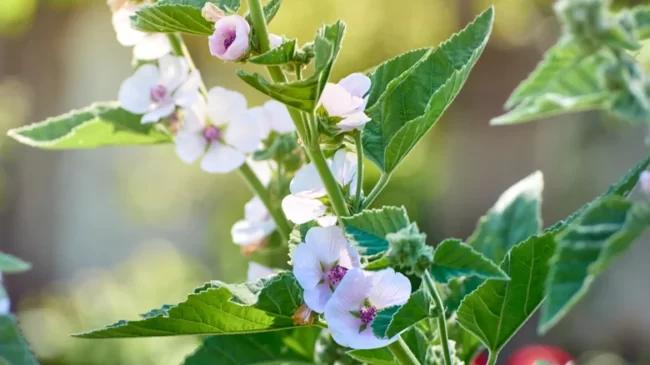
The marshmallow plant!
This evening, Chuck brought square-shaped marshmallows to the pit.

We are experts!
Scout was welcomed to the pit, but his shaggy tail kept flopping into the fire, and we had to save him from becoming a crispy critter.

Just us!
Colleen crashed earlier, and we hit at about 10:00 pm as we must be up early to go to the airport at 6:30 am.
